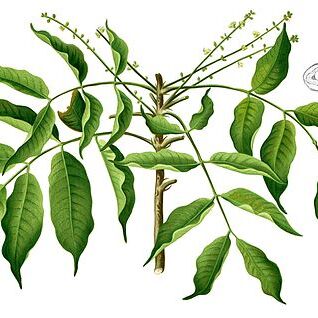A large tree. It grows 8-15 m tall but can grow 30 m tall. The trunk is 1.5 m across. The trunk is straight and it branches high up. The bark is brown with black sap. The leaves are unequal. The leaflets are long and oval. They are 6-12 cm long by 3-6 cm wide. They are shiny above and dark coloured underneath. There are 8-10 pairs of side veins. The leaf shape of seedlings varies. The leaves have 4-6 pairs of leaflets. The flower clusters are branched. The flowering stalks are 8-35 cm long with 1-4 fruit on long stalks. The flowers are white. The fruit are narrowly oval and fleshy. They are 3-4 cm long by 1-2 cm wide. There are 3 unequal cells. The fruit are dark reddish blue to black when ripe. They contain 1 or 2 seeds.

